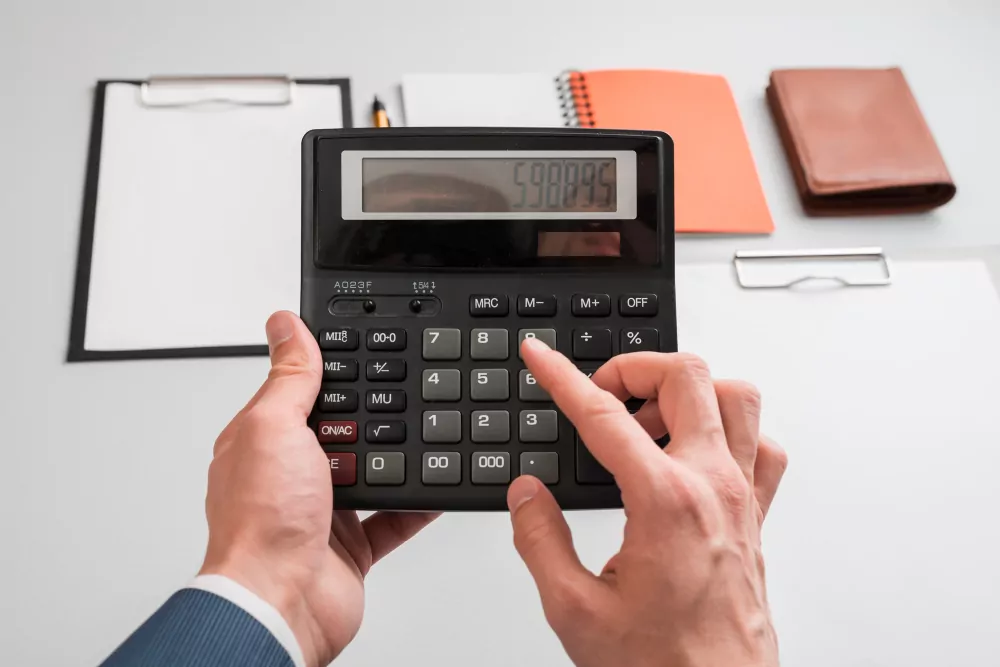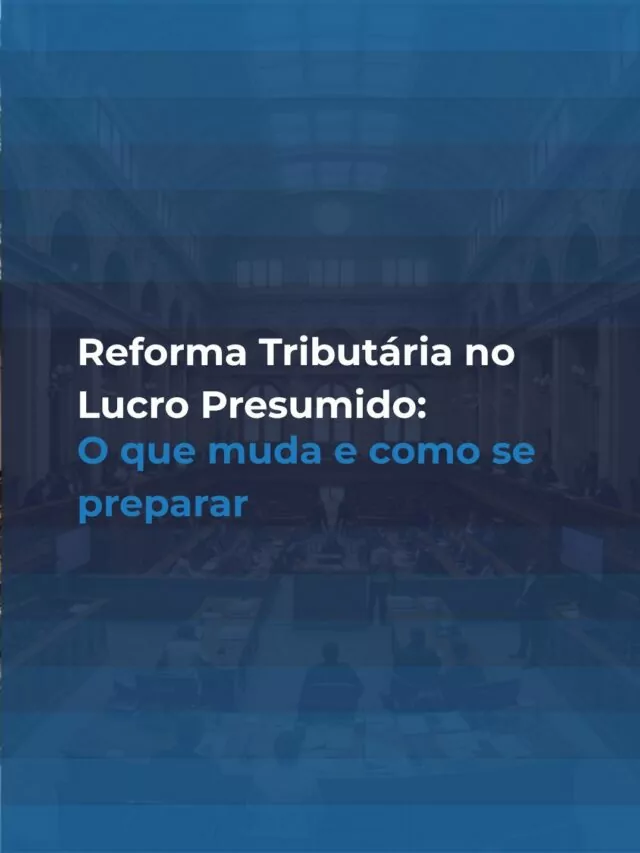O calculating income tax in Brazil follows a progressive model based on income brackets, with rates increasing according to the amount of taxable income. In simple terms, this means that those who earn more pay a higher percentage of tax.
Every year, individuals have to declare their income for the previous year and calculate whether there is tax to pay or refund. When tax is due, it is possible to pay it off in cash or in installments. But what happens if the taxpayer is late or fails to pay these installments?
In this introduction, we're going to clearly explain how income tax is calculated and the consequences of not paying it or paying it late.
When sending the annual declaration, the Internal Revenue Service automatically calculates the tax due based on the information provided. If there is a balance of tax to pay, the taxpayer can issue a DARF (Documento de Arrecadação de Receitas Federais) for payment.
The traditional deadline for paying the first installment (or single installment) usually coincides with the last day for submitting the tax return. If you choose to pay in installments, the remaining installments are subject to interest and must be paid in the following months. Failure to pay or delaying these income tax installments can lead to interest, fines and other penaltiesincluding having the CPF irregular ("blocked") and having the debt inscribed in Union Active Debt, among other consequences that we will detail below.
Do you want to understand how the new income tax exemption band could affect your payment in 2026?
In the podcast episode Business in Brazil Today, Beatriz Oliveira talks to Marco Aurélio Ribeiro and Rodrigo Ribeiro about the changes in calculating income tax and what will change for those who need to file a tax return.
They explain, in a simple and straightforward way, who will benefit from the exemption of up to R$ 5,000 per month and how to plan so as not to fall into the fine mesh.
Listen to the full episode and find out how to prepare for the next declaration!
How is income tax calculated?
Individual Income Tax (IRPF) is calculated based on the taxpayer's annual income, applying the progressive table by income bracket. This means that parts of your income are taxed at different rates. Before applying the rates, however, you need to define the calculation basisIn other words, the amount of income subject to taxation after the deductions allowed by law. See the simplified step-by-step:

1 - Add up your taxable income: include salaries, bonuses, rents and other income subject to income tax.
2 - Subtract the legal deductions: from your total income, you can deduct some amounts provided for by law, such as contributions to the official social security system (INSS), medical expenses, educational expenses (up to an annual limit), legal alimony and deduction per dependent (a fixed amount per dependent).
For example, in calendar year 2023, each dependent can deduct R$ 2,275.08 from their annual taxable income. There is also the option of simplified discount of 20% (if the taxpayer opts for the simplified declaration), limited to R$ 16,754.34 in the year 2023.
This discount replaces all individual deductions, making the calculation easier for those who don't have many deductible expenses.
3 - Calculate the tax base: after deductions, the tax base is obtained. It is on this value that the rates of the progressive table will be applied.
4 - Apply the progressive rate table: every year, the Federal Revenue Office publishes the updated income tax table by income bracket. As of fiscal year 2024 (calendar year 2023), the annual table looks like this:
| Annual Calculation Basis (Taxable Income) | IRPF rate | Deductible portion |
|---|---|---|
| Up to R$ 24,511.92 | Exempt (0%) | R$ 0,00 |
| From R$ 24,511.93 to R$ 33,919.80 | 7.5% | R$ 1,838.39 |
| From R$ 33,919.81 to R$ 45,012.60 | 15% | R$ 4,382.38 |
| From R$ 45,012.61 to R$ 55,976.16 | 22.5% | R$ 7,758.32 |
| Above R$ 55,976.16 | 27.5% | R$ 10,557.13 |
Progressive income tax table for the calendar year 2023 (declaration in 2024). Source: Receita Federal.
Each income bracket has a corresponding rate and a fixed portion to deduct, which simplifies the calculation of the tax due in each bracket.
For example, rents up to R$ 24,511.92 per year are exempt income that exceeds this amount pays 7.5% on the portion that exceeds R$ 24,511.92, and so on, up to the maximum rate of 27.5% for the portion of income that exceeds R$ 55,976.16 annually

5 - Calculate the tax due: with the calculation basis and the table in hand, you calculates the amount of IR due. You can either directly apply the formula in the table (Rate * Base - Portion to be deducted) to the bracket you fall into, or add up the tax bracket by bracket.
Practical example: imagine that, after deductions, your annual taxable income was R$ 50.000,00. According to the table, this income is in the range of 22.5%. We calculate 22.5% of R$ 50,000 = R$ 11,250and then deduct the portion of R$ 7,758.32 (specific to this band). The tax due would be R$ 3,491.68 in that case.
6 - Subtract the payments already made: of the calculated tax, you will also deduct any amounts already paid during the year, such as IR source (monthly withholdings from your salary, for example), or capital gains tax, etc. After subtracting these advance payments, you find out if there is still tax to pay or if you are entitled to a refund.
7 - Payment of the assessed tax: if after all the calculations there are tax payableThe taxpayer must issue the DARF and pay the amount on time. It is possible to pay your income tax in installments if the amount due is more than R$ 100.00.
The standard installment plan offered in the declaration is up to 8 monthly installmentsThe first installment is due on the due date of the tax return (usually April or May, according to the annual tax calendar), provided that each installment is at least R$ 50.00. The first installment is due on the deadline for filing the tax return (usually in April or May, according to the tax office's annual calendar), and the others are due on the last working day of the following months.
It is worth remembering that pay your income tax in installments already in the declaration, the installments from the second onwards are increased by interest (Selic rate) and 1% interest on arrears, calculated in accordance with the legislation in force.
8 - Refund, if any: if your tax payments during the year exceeded the tax due (for example, if your employer withheld more income tax than necessary), the program will inform you of an amount to be refunded. This refund is returned by the Federal Government in batches, after the declaration, following an annual schedule.
In short, the calculating income tax involves knowing your tax base, applying the updated progressive table (which is amended periodically by law - for example, a Law 14.663/2023 adjusted the table and raised the exemption band in 2023), and then check how much has already been paid and how much still needs to be paid. In the next section, we'll see what happens if, after all this process, the taxpayer not paying the DARF or delaying installments chosen.
What happens if you don't pay your income tax?
Failing to pay the income tax calculated in the return or delaying the installments entails a series of consequences provided for in tax legislation. The situation "I split my income tax and didn't pay it" is more common than you might think, and it's important to understand the charges and penalties involved. Check out the main effects of non-payment:
Fine for late payment
If the IRPF is paid late, the following applies late payment penalty of 0.33% per day, limited to 20% of the amount due. It starts on the day after the due date and stops increasing when it reaches the ceiling. This penalty is provided for in Law No. 9.430/1996 and aims to discourage default.
Interest on arrears (Selic rate)
In addition to the fine, the following charges are levied interest based on the Selic rateaccumulated month by month from the month following the due date until the month preceding payment, with Additional 1% in the month of payment. As the Selic rate varies, the value of the debt increases with the length of the delay.
Loss of right to installment payment
Those who pay their income tax in installments and fail to pay three consecutive or alternating installments has the agreement automatically terminated. In this case, the remaining amount will be charged in full, with a fine and interest. A failure to pay the first installment you can cancel the installment plan immediately.
Inscription in the Union's Active Debt
If the debt is not paid, it can be entered in the Union Active Debtallowing judicial recovery by PGFN. This includes seizure of assets, blocking of accounts and collection of fees. Active debt prevents the issuance of CNDThis is necessary for financing, tenders, real estate sales and other processes.
Irregular or "blocked" CPF
Taxpayers with debts can have the CPF marked as "pending regularization"making it difficult loans, public tenders and issuing documents. Although there is no automatic denial in services such as Serasa, this pendency acts as a warning in the public and financial system.
Fine for failure to declare
Failure to file your tax return on time generates a specific fine, even if you don't have to pay tax. The minimum amount is R$ 165.74 and can reach 20% of tax due. This fine is different from the fine for late payment.
Tax enforcement and legal measures
If the debt remains in the Active Debt, the PGFN can file for tax execution based on Law No. 6.830/1980, making it possible to seizure of assets, blocking of accounts and other legal actions. This generates additional costs and the risk of losing assets in order to pay off the debt.
In a nutshell, failure to pay income tax in installments or when due generates immediate financial charges (fines and interest) and can lead to serious registration and legal problems. The recommendation is always to try regularize as soon as possible to avoid the accumulation of charges and complications. In the next topic, we'll discuss just what forms of regularization and renegotiation are available.
Do you already know what the biggest tax change in Brazil is? Hit play and get up to speed now!
How to settle or renegotiate overdue income tax?
If you are in default with the Lion, either because I split my income tax and didn't pay it quotas, or because I simply missed the deadline, it is essential to know that there are ways to regularize the situation. The measures to be taken will depend on the stage the debt has reached:
Cash payment with updated DARF
If the delay is recent (such as forgetting to pay the single DARF or missing the due date for an installment), the simplest way to resolve it is to issue a new updated form with fine and interest. This can be done by Sicalcweb or by e-CAC portalwhere the system already calculates the accruals up to the date of payment.
How late payment penalty is 0.33% per dayThe sooner the payment is made, the lower the final amount will be. For small arrears, simply issue the overdue DARF and pay it off as soon as possible, with no major consequences if this happens before any tax action is taken.
Simplified installment payment via e-CAC
If the amount owed is high and cannot be paid in one go, it is possible to pay the debt in up to 60 installments by e-CAC portal. The minimum amount is usually R$ 200.00 per installment (for old debts), unlike the installment payment made in the declaration, which requires R$ 50.00 per plot.
The process is completely online: when you access e-CAC with your CPF, just go to "Payments and Installments" > "Installments - Request and Track"select the outstanding debts and simulate a new installment plan.
To formalize the agreement, it is necessary to pay the first installmentThe rest can be debited automatically from the bank account. If the debt is already registered in the PGFN (Active Debt)The installments must be made directly there.
Debt negotiation with PGFN (Regularize)
If the debt has been registered as an Active Federal Debt, the negotiation is carried out by the PGFN on the portal Regularize. In this environment, there are traditional installments and tax transactionwhich can offer discounts of up to 40% or 50% on fines and interestas provided for in Law No. 13.988/2020 and in specific ordinances.
The portal allows you to check if your debt is eligible for a special negotiation program. The minimum installment for individuals usually varies between R$ 100,00 and R$ 200,00depending on the modality chosen.
Prioritize regularization to avoid major penalties
Ignoring the debt only aggravates the situation, as it continues to grow and can generate CPF restrictions, registration as an Active Debt e judicial recovery.
If you are unable to pay the full amount, paying in installments is better than taking out expensive loanssince the interest on IR installments is lower than credit cards or overdrafts.
Renegotiation in exceptional cases
In situations of proven financial difficultyyou can ask for revision or special installment plan with the IRS. However, the rules of fines and interest are defined by law and cannot be waived administratively.
Reductions or amnesties only occur in tax regularization programs (REFIS or transactions) or by court decision. In most cases, the alternative available is to pay the debt in installments and take advantage of any discount programs when they arise.
Frequently asked questions
1. How personal income tax is calculated
The calculation of IRPF uses the annual progressive table on the taxpayer's taxable income.
First, all the taxable income of the year and subtract the allowable deductions (social security, health, education up to the limit, dependents, etc.).
With the calculation basis defined, the rate of the corresponding band and deduct the fixed portion.
Then you subtract the amounts already paid (withholding tax, tax return) to arrive at the tax payable or refund.
Example: annual income of R$ 50,000 after deductions - approx. R$ 24.5 thousand are exemptThe remainder is taxed in three bands (7.5%, 15% and 22.5%), resulting in approximately R$ 3,490 tax in the year.
2. Can I pay my income tax in installments?
Yes. At the time of filing, if the tax is higher than R$ 100you can pay in installments of up to 8 times a month, with minimum of R$ 50 per plot.
A first installment due at the tax return deadline and the rest on the last working day of each month. From the second day onwards 1% interest + Selic accumulated per month.
If the debt is from previous years, it can be paid in installments of up to 60 times via e-CAC, with a minimum portion of around R$ 200. All you have to do is go to the Installments section and negotiate the debt.
3. What happens if I don't pay the Income Tax DARF?
Non-payment generates late payment penalty of 0.33% per day (up to 20%) e interest based on the monthly Selic rate.
Over time, the CPF can become irregularThis makes it difficult to access credit and services.
If the debt is not paid, it can be registered in Union Active Debtsubject to judicial collection, blocking of assets and other penalties.
Failure to pay means spending more on charges and facing increasingly serious consequences.
4."I paid the tax and didn't pay it", what should I do?
Regularize as soon as possible. It is possible issue the updated DARF of the overdue installments and pay them with a fine and proportional interest.
Delay up to two installments isolated installments can still be maintained, as long as they are paid off.
If you're late three installments (consecutive or not)The installment plan is canceled.
If the debt is already old, you can redo the installment payment through e-CAC (if it's still at Receita) or on the Regularize/PGFN portal (if it is in Active Debt).
It is also advisable to seek professional advice to assess the best alternative.
Read also: Will dividends be taxed in 2026? Understand what's changing and how to prepare

Conclusion
In short: delaying or failing to pay your Income Tax installments can generate interest and fines, make your CPF irregular and even result in the debt being registered as an Active Federal Debt, with legal collection and other headaches. The best course of action is to act quickly: issue the outstanding DARFs, regularize the situation and avoid further penalties.
A CLM Controller is an accounting firm with over 40 years' experience, specializing in guiding individuals and companies through all stages of the tax process. Our team handles the regularization of your IRPF with precision and security - from the detailed analysis of pending issues to the correct installment payment of debts and the prevention of new assessments. With CLM by your side, you can keep your tax situation up to date and avoid future problems with the IRS.










